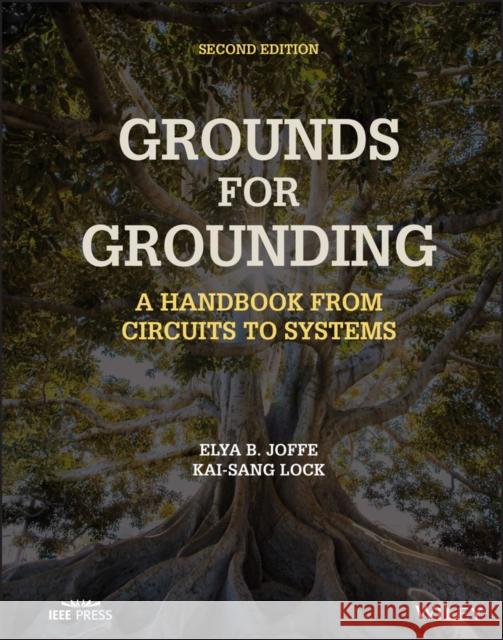Grounds for Grounding: A Handbook from Circuits to Systems » książka



Grounds for Grounding: A Handbook from Circuits to Systems
ISBN-13: 9781119770930 / Angielski / Twarda / 2023 / 1100 str.
Grounds for Grounding: A Handbook from Circuits to Systems
ISBN-13: 9781119770930 / Angielski / Twarda / 2023 / 1100 str.
(netto: 608,75 VAT: 5%)
Najniższa cena z 30 dni: 635,25
ok. 30 dni roboczych
Dostawa w 2026 r.
Darmowa dostawa!
Preface to the Second Edition ixPreface to First Edition xiAbout the Companion Website xiii1 What is Density Functional Theory? 11.1 How to Approach This Book 11.2 Examples of DFT in Action 21.2.1 Ammonia Synthesis by Heterogeneous Catalysis 21.2.2 Embrittlement of Metals by Trace Impurities 31.2.3 Materials Properties for Modeling Planetary Formation 41.2.4 Screening Large Collections of Materials to Develop Photoanodes 51.3 The Schrödinger Equation 71.4 Density Functional Theory - From Wavefunctions to Electron Density 91.5 The Exchange-Correlation Functional 121.6 The Quantum Chemistry Tourist 131.6.1 Localized and Spatially Extended Functions 131.6.2 Wavefunction-Based Methods 151.6.3 The Hartree-Fock Method 151.6.4 Beyond Hartree-Fock 181.7 What Can DFT Not Do? 221.8 Density Functional Theory in Other Fields 231.9 How to Approach This Book (Revisited) 241.10 Which Code Should I Use? 25Further Reading 26References 272 DFT Calculations for Simple Solids 292.1 Periodic Structures, Supercells, and Lattice Parameters 292.2 Face-Centered Cubic Materials 312.3 Hexagonal Close-Packed Materials 322.4 Crystal Structure Prediction 352.5 Phase Transformations 35Exercises 37Further Reading 37Appendix - Calculation Details 38Reference 383 Nuts and Bolts of DFT Calculations 393.1 Reciprocal Space and k-Points 403.1.1 Plane Waves and the Brillouin Zone 403.1.2 Integrals in k-Space 423.1.3 Choosing k-Points in the Brillouin Zone 433.1.4 Metals - Special Cases in k-Space 473.1.5 Summary of k-Space 483.2 Energy Cutoffs 493.2.1 Pseudopotentials 503.3 Numerical Optimization 513.3.1 Optimization in One Dimension 523.3.2 Optimization in More Than One Dimension 543.3.3 What Do I Really Need to Know About Optimization? 573.4 DFT Total Energies - An Iterative Optimization Problem 583.5 Geometry Optimization 593.5.1 Internal Degrees of Freedom 593.5.2 Geometry Optimization with Constrained Atoms 613.5.3 Optimizing Supercell Volume and Shape 61Exercises 62Further Reading 63Appendix - Calculation Details 64References 644 Accuracy of DFT Calculations 654.1 How Accurate are DFT Calculations? 654.2 Choosing a Functional 694.3 Examples of Physical Accuracy 734.3.1 Benchmark Calculations for Molecular Systems - Energy and Geometry 744.3.2 Benchmark Calculations for Molecular Systems - Vibrational Frequencies 754.3.3 Crystal Structures and Cohesive Energies 754.3.4 Adsorption Energies and Bond Strengths 764.4 When Might DFT Fail? 77Exercises 78Further Reading 79References 795 DFT Calculations for Surfaces of Solids 815.1 Why Surfaces are Important 815.2 Periodic Boundary Conditions and Slab Models 825.3 Choosing k-Points for Surface Calculations 855.4 Classification of Surfaces by Miller Indices 855.5 Surface Relaxation 885.6 Calculation of Surface Energies 915.7 Symmetric and Asymmetric Slab Models 925.8 Surface Reconstruction 935.9 Adsorbates on Surfaces 955.9.1 Accuracy of Adsorption Energies 985.10 Effects of Surface Coverage 995.11 DFT Calculations for Grain Boundaries 101Exercises 102Further Reading 103Appendix - Calculation Details 104References 1056 DFT Calculations of Vibrational Frequencies 1076.1 Isolated Molecules 1076.2 Vibrations of a Collection of Atoms 1106.3 Molecules on Surfaces 1126.4 Zero-Point Energies 1146.5 Reaction Energies at Finite Temperatures 1186.6 Phonons and Delocalized Modes 119Exercises 120Further Reading 120Appendix - Calculation Details 121Reference 1227 Calculating Rates of Chemical Processes Using Transition State Theory 1237.1 One-Dimensional Example 1247.2 Multidimensional Transition State Theory 1287.3 Finding Transition States 1317.3.1 Elastic Band Method 1327.3.2 Nudged Elastic Band Method 1347.3.3 Initializing NEB Calculations 1357.4 Finding the Right Transition States 1377.5 Connecting Individual Rates to Overall Dynamics 1397.6 Quantum Effects and Other Complications 1417.6.1 High Temperatures/Low Barriers 1427.6.2 Quantum Tunneling 1427.6.3 Zero-Point Energies 142Exercises 143Further Reading 144Appendix - Calculation Details 145Reference 1468 Predicting Equilibrium Phase Diagrams and Electrochemistry Using Open Ensemble Methods 1478.1 Stability of Bulk Metal Oxides 1488.1.1 Examples Including Disorder - Configurational Entropy 1528.2 Stability of Metal and Metal Oxide Surfaces 1548.3 DFT for Electrochemistry: The Computational Hydrogen Electrode 1568.4 Using DFT to Predict Dissolution of Solids in Electrochemical Environments 159Exercises 161Further Reading 162Appendix - Calculation Details 163References 1639 Electronic Structure and Magnetic Properties 1659.1 Electronic Density of States 1659.2 Local DOS and Atomic Charges 1709.3 Magnetism 172Exercises 174Further Reading 174Appendix - Calculation Details 17510 Ab Initio Molecular Dynamics 17710.1 Classical Molecular Dynamics 17710.1.1 Molecular Dynamics with Constant Energy 17710.1.2 Molecular Dynamics in the Canonical Ensemble 17910.1.3 Practical Aspects of Classical Molecular Dynamics 18010.2 Ab Initio Molecular Dynamics 18010.3 Applications of Ab Initio MD 18210.3.1 Exploring Structurally Complex Materials: Liquids and Amorphous Phases 18210.3.2 Exploring Complex Energy Surfaces 183Exercises 186Further Reading 186Appendix - Calculation Details 188References 18811 Methods Beyond "Standard" Calculations 18911.1 Estimating Uncertainties in DFT 18911.2 DFT+X Methods for Improved Treatment of Electron Correlation 19111.2.1 Dispersion Interactions and DFT-D 19111.2.2 Self-Interaction Error, Strongly Correlated Electron Systems and DFT+U 19211.3 Random Phase Approximation 19411.4 TD-DFT 19611.5 Larger System Sizes with Linear Scaling Methods and Classical Forcefields 19711.6 Conclusion 197Further Reading 198References 199Index 201
Elya B. Joffe is President of Elya Joffe - Electromagnetic Solutions, Ltd. He holds a B.ScEE from Ben Gurion University, Israel, and is a Registered Professional Engineer. Elya is an IEEE Life Senior Member, and Past President of the IEEE EMC and Product Safety Engineering Societies. Elya has received many awards from the IEEE and EMC Society, particularly the prestigious IEEE EMC Society 2002 Laurence G. Cumming Award for Outstanding Service and the 2006 IEEE RAB Larry K. Wilson Transnational Award. He is an iNARTE-certified EMC and ESD Control Engineer, and is a Member of IEEE-HKN and dB Society.Kai-Sang Lock, PhD, is a Professor of Engineering at the Singapore Institute of Technology. He has been a practicing Professional Engineer for over 20 years. He is a Fellow of the Academy of Engineering Singapore, a Fellow of the Institution of Engineering and Technology, UK, an Honorary Fellow of the Institution of Engineers, Singapore, as well as a Life Senior Member of IEEE. He was a President of the Institution of Engineers, Singapore, a past Board Member of the Professional Engineers Board, and a past Chairman of the Singapore Standards Council.
1997-2025 DolnySlask.com Agencja Internetowa
KrainaKsiazek.PL - Księgarnia Internetowa









